
The Woman's Christian Temperance Union (WCTU) is an active international temperance organization that was among the first organizations of women devoted to social reform with a program that "linked the religious and the secular through concerted and far-reaching reform strategies based on applied Christianity." It plays an influential role in the temperance movement. The organization supported the 18th Amendment and was also influential in social reform issues that came to prominence in the progressive era.

Frances Elizabeth Caroline Willard was an American educator, temperance reformer, and women's suffragist. Willard became the national president of Woman's Christian Temperance Union (WCTU) in 1879 and remained president until her death in 1898. Her influence continued in the next decades, as the Eighteenth and Nineteenth Amendments to the United States Constitution were adopted. Willard developed the slogan "Do Everything" for the WCTU and encouraged members to engage in a broad array of social reforms by lobbying, petitioning, preaching, publishing, and education. During her lifetime, Willard succeeded in raising the age of consent in many states as well as passing labor reforms including the eight-hour work day. Her vision also encompassed prison reform, scientific temperance instruction, Christian socialism, and the global expansion of women's rights.

North Terrace is one of the four terraces that bound the central business and residential district of Adelaide, the capital city of South Australia. It runs east–west, along the northern edge of "the square mile". The western end continues on to Port Road, and the eastern end continues across the Adelaide Parklands as Botanic Road.

Main North Road is the major north-south arterial route through the suburbs north of the Adelaide City Centre in the city of Adelaide, South Australia. It continues north through the settled areas of South Australia and is a total of 307 kilometres (191 mi) long, from North Adelaide to 21 kilometres (13 mi) out of Port Augusta. It follows the route established in the early years of the colony by explorer John Horrocks and was a major route for farmers and graziers to reach the capital, passing through rich farmland and the Clare Valley wine region. In 2011, the section of road between Gawler to Wilmington was renamed Horrocks Highway.
Kensington Road is a main road in the South Australian capital city of Adelaide. It serves the eastern suburbs, primarily the northern side of the City of Burnside and the southern side of the City of Norwood, Payneham & St Peters. Its western end, on the edge of the city centre, is at the Britannia Roundabout on the City Ring Route. Kensington Road continues into the city centre as Wakefield Road.

Adelaide city centre is the inner city locality of Greater Adelaide, the capital city of South Australia. It is known by locals simply as "the City" or "Town" to distinguish it from Greater Adelaide and from the City of Adelaide local government area. The population was 15,115 in the 2016 census.

Wellington Street is the northernmost of the four primary east-west streets in the central business district of Perth, Western Australia. It is 3.7 kilometres (2.3 mi) long, stretching from Plain Street in East Perth to Thomas Street in West Perth.
Calvary Hospital North Adelaide is a private, not-for-profit Catholic hospital in North Adelaide.
The Calvary Wakefield Hospital, formerly Private Hospital, Wakefield Street (PHWS) and variants, Wakefield Street Private Hospital, Wakefield Memorial Hospital and Wakefield Hospital, referred to informally as "the Wakefield", was a private hospital founded around 1883–4 on Wakefield Street in Adelaide, South Australia. In 2006 it was acquired by Little Company of Mary Health Care Ltd., a Catholic non-profit organisation, before being replaced by a newly-constructed hospital, the Calvary Adelaide Hospital.

Gilles Street is a street in the south-eastern sector of the centre of Adelaide, South Australia. It runs east–west between East Terrace and King William Street, crossing Hutt Street and Pulteney Street. It was named after Osmond Gilles, an early treasurer of the colony of South Australia on 23 May 1837.
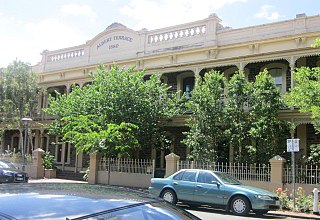
Carrington Street is a street in the south-eastern sector of the centre of Adelaide, South Australia. It runs east–west, from East Terrace to King William Street, blocked at Hutt Street and crossing Pulteney Street at Hurtle Square. It is one of the narrow streets of the Adelaide grid, at 1 chain wide.

Hutt Street is the most easterly of the five major north–south roads running through the City of Adelaide. It runs from Pirie Street to South Terrace, from where it continues south as Hutt Road. Hutt Street is named after Sir William Hutt, a British MP who was heavily involved in colonial South Australia.

East Terrace marks the eastern edge of the Adelaide city centre. It is one of the main north–south thoroughfares through the east side of the city. Although the terrace essentially runs north–south between North Terrace and South Terrace, unlike Adelaide's other three terraces, its path is far from a straight line; travelling the entire length of East Terrace requires turning at right angles at most intersections from Pirie Street onwards. These days however, the traffic flow, after a swerve to the east between Grenfell and Pirie Streets, continues southwards over the Pirie intersection into Hutt Street and on down to South Terrace.

Grote Street is a major street in the CBD of the centre of Adelaide, South Australia. It runs in an east–west direction, as a continuation of Wakefield Street where it crosses Victoria Square. It concludes at West Terrace; the road which continues is Sir Donald Bradman Drive. The Grote Street–Sir Donald Bradman Drive route is the most direct method of travelling from the CBD to the Adelaide Airport.
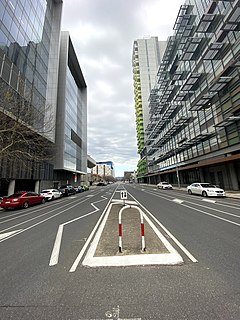
Angas Street is a main street in the CBD of the centre of Adelaide, South Australia. The rear of St Aloysius College faces the street, and various law courts are on the street, including the Dame Roma Mitchell Building. The South Australia Police headquarters and South Australian Metropolitan Fire Service Adelaide station are further down the street.
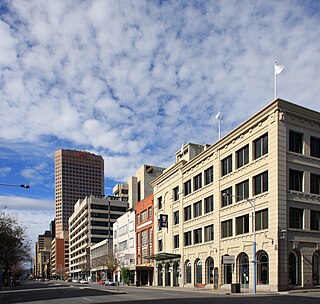
Currie Street is a main street in the Adelaide city centre, South Australia. It runs east–to–west from King William Street, through Light Square, to West Terrace on the western edge of the city centre.
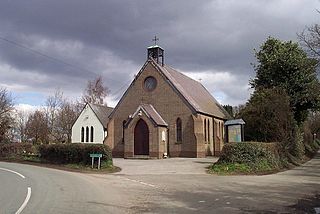
Hatherton is a settlement and civil parish located 3+1⁄4 miles (5.2 km) south-east of Penkridge, and on the western edge of modern-day Cannock, Staffordshire, England, and lying adjacent to and north of Watling Street, now the A5.
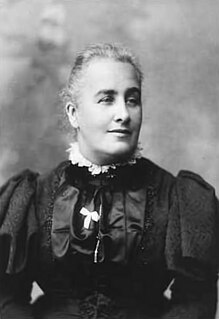
Elizabeth Webb Nicholls was a key suffragist in the campaign for votes for women in South Australia during the 1890s. She took on several high-profile roles in the capital of South Australia, Adelaide and was President of the Woman's Christian Temperance Union (WCTU) of South Australia, one of the most prominent organisations in the successful campaigns which made South Australia the first of the Australian colonies to grant women the right to vote in 1894.
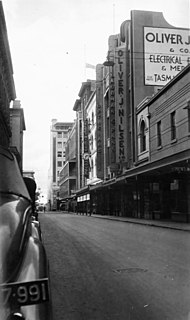
Gawler Place is a single-lane road in the city centre of Adelaide, the capital of South Australia. It runs north to south from North Terrace to Wakefield Street, parallel to and approximately midway between King William and Pulteney Streets.
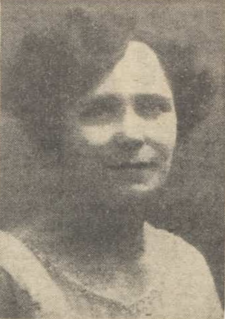
Isabella McCorkindale, known as Isabel, was a Scottish-born Australian temperance, suffrage and women's rights activist. She was a leader in both the Women's Christian Temperance Union of Australasia (WCTUA) and the World Women's Christian Temperance Union (WWCTU). As director of scientific temperance education for the WCTUA, she spent more than 40 years working to educate young people about the health and social consequences of alcohol abuse. She was international president of WWCTU from 1959 to 1962, after serving as vice-president from 1947 to 1959. She then served as national president for the Australian WCTU from 1963 to 1966. In 1961, she was appointed a Member of the Order of the British Empire for her work.

















